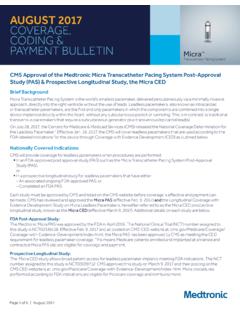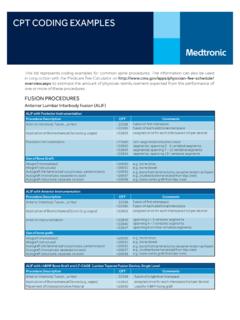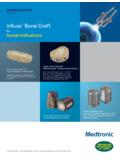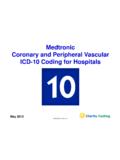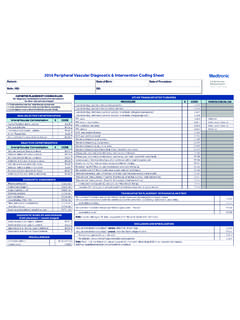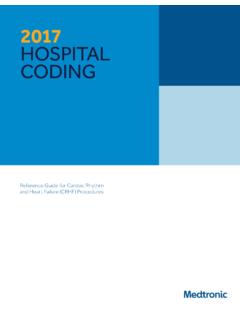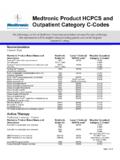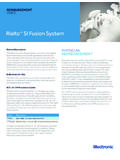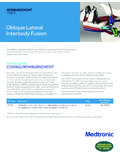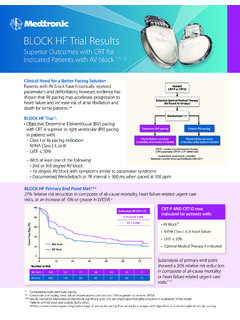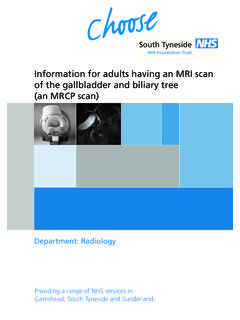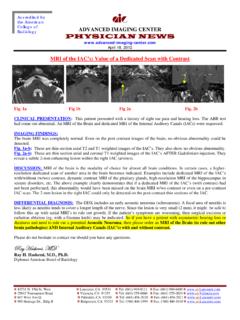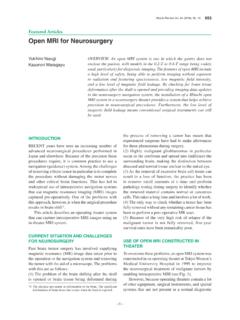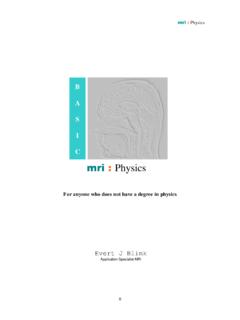Transcription of MR-CONDITIONAL CARDIAC DEVICE SUMMARY …
1 MR-CONDITIONAL CARDIAC DEVICESUMMARY CHARTTHERAPYPRODUCTMODEL NUMBERMR CONDITIONALMR SYSTEMSURESCAN LEADSPACEM A K ERSM icra MC1VR01Ye sHorizontal cylindrical bore or 3 TNot ApplicableAdvisa MRI A2DR01, A3SR01 Yes If complete system is implanted with a SureScan pacemaker and SureScan lead(s) or 3T Pacing leads: 3830: 59, 69, 74 cm 4076: 35, 45, 52, 58, 65, 85 cm4074: 52, 58 cm4574: 45, 53 cm 5086 MRI: 45, 52, 58 cm 5076: 35, 45, 52, 58, 65, 85 cmHorizontal cylindrical bore onlyRevo MRI RVDR01 CARDIAC DEFIBRILLATORSV isia AF MRI DVFB1D1*, DVFB1D4 Yes If complete system is implanted with a SureScan ICD and SureScan lead(s)Horizontal cylindrical bore or or 3T Defibrillation leads: DF4: 6947M, 6946M, and 6935M Lengths 55, 62 cmDF-1: 6947 and 6935 Lengths 58, 65 cmSee above for pacing leads. Visia AF MRI SDVFC3D1*, DVFC3D4 Evera MRI XTDDMB1D4, DVMB1D4,DDMB1D1*Evera MRI SDDMC3D4, DDMC3D1* CARDIAC RESYNCHRONIZATION THERAPY DEFIBRILLATORSC laria MRI Quad CRT-DDTMA1QQ, DTMA1Q1*Yes If complete system is implanted with a SureScan CRT-D and SureScan lead(s) or the Model 6725 pin plugHorizontal cylindrical bore magnet or or 3T CRT leads: 4196, 4296, 4396 Lengths: 78, 88 cm4298, 4398, 4598 Lengths.
2 78, 88 cmSee above for defibrillation and pacing MRI CRT-DDTMA1D4, DTMA1D1*Amplia MRI Quad CRT-DDTMB1QQ, DTMB1Q1*Amplia MRI CRT-DDTMB1D4, DTMB1D1*Compia MRI Quad CRT-DDTMC1 QQCompia MRI CRT-DDTMC1D1*INSERTABLE CARDIAC MONITORSR eveal LINQ LNQ11 Yes Horizontal cylindrical bore or 3 TNot ApplicableReveal XT9529Ye sClosed bore, cylindrical or 3T* When a single coil SureScan defibrillation lead is used, a Medtronic DF-1 pin plug must be secured in the SVC port to make a complete SureScan DF-1 defibrillation 2017 The chart below contains all Medtronic CARDIAC devices FDA approved for MRI scans under specific conditions for use. If a model number and/or lead length is not listed, then it is not FDA approved for the MR To obtain the MR Conditions for Use, go to or Statement Medtronic SureScan Portfolio for and 3T MR-CONDITIONAL UseMedtronic SureScan products and systems are MR conditional , and as such are designed to allow patients to undergo MRI under the specified conditions for , ICD, and CRT-D Systems: When programmed to On, the MRI SureScan feature allows the patient to be safely scanned while the DEVICE continues to provide appropriate pacing.
3 A complete transvenous SureScan system, which is a SureScan DEVICE with appropriate SureScan lead(s), is required for use in the MR environment. When a single coil SureScan defibrillation lead is used, a Medtronic DF-1 pin plug must be secured in the SVC port to make a complete SureScan DF-1 defibrillation system. To verify that components are part of a SureScan system, visit Any other combination may result in a hazard to the patient during an MRI The SureScan Advisa MRI and Revo MRI pacing systems are indicated for rate adaptive pacing in patients who may benefit from increased pacing rates concurrent with increases in activity. Dual chamber SureScan pacing systems are also indicated for dual chamber and atrial tracking modes in patients who may benefit from maintenance of AV SureScan Evera MRI and Visia AF MRI defibrillation systems are indicated to provide ventricular antitachycardia pacing and ventricular defibrillation for automated treatment of life-threatening ventricular arrhythmias.
4 In addition, the dual chamber devices are indicated for use in the above patients with atrial tachyarrhythmias, or those patients who are at significant risk of developing atrial Claria MRI /Amplia MRI /Compia MRI CRT-D systems are indicated for ventricular antitachycardia pacing and ventricular defibrillation for automated treatment of life-threatening ventricular arrhythmias and for providing CARDIAC resynchronization therapy in heart failure patients on stable, optimal heart failure medical therapy if indicated, and meet any of the classifications detailed in the specific DEVICE manuals. New York Heart Association (NYHA) Functional Class III or IV and who have a left ventricular ejection fraction 35% and a prolonged QRS duration. Left bundle branch block (LBBB) with a QRS duration 130 ms, left ventricular ejection fraction 30%, and NYHA Functional Class II. NYHA Functional Class I, II, or III and who have left ventricular ejection fraction 50% and atrioventricular block (AV block) that are expected to require a high percentage of ventricular pacing that cannot be managed with algorithms to minimize right ventricular pacing.
5 Optimization of heart failure medical therapy that is limited due to AV block or the urgent need for pacing should be done post-implant. Claria/Amplia only: Some CRT-D system are also indicated for use in patients with atrial tachyarrhythmias, or those patients who are at significant risk for developing atrial Model MC1VR01 is indicated for patients with symptomatic paroxysmal or permanent high grade AV block in the presence of AF. It is also indicated in the absence of AF as an alternative to dual chamber pacing, or symptomatic bradycardia-tachycardia syndrome or sinus node dysfunction (sinus bradycardia/sinus pauses) when atrial lead placement is considered difficult, high risk, or not deemed necessary for effective Reveal LINQ insertable CARDIAC monitor (ICM) is an implantable patient-activated and automatically-activated monitoring system that records subcutaneous ECG and is indicated for patients with clinical syndromes or situations at increased risk of CARDIAC arrhythmias, or patients who experience transient symptoms such as dizziness, palpitation, syncope, and chest pain that may suggest a CARDIAC The SureScan transvenous pacing systems are contraindicated for implantation with unipolar pacing leads (Revo MRI only)
6 , concomitant implantation with another bradycardia DEVICE , or an implantable cardioverter IPG is contraindicated for patients who have the following types of medical devices implanted: an implanted DEVICE that would interfere with the implant of the Micra DEVICE in the judgment of the implanting physician, an implanted inferior vena cava filter, a mechanical tricuspid valve, or an implanted CARDIAC DEVICE providing active CARDIAC therapy that may interfere with the sensing performance of the Micra DEVICE or for patients who have the following conditions: femoral venous anatomy unable to accommodate a mm (23 French) introducer sheath or implant on the right side of the heart (for example, due to obstructions or severe tortuosity), morbid obesity that prevents the implanted DEVICE from obtaining telemetry communication within cm ( in), or known intolerance to the materials listed in the Instruction for Use, or to heparin, or sensitivity to contrast media that cannot be adequately defibrillation and CRT-D systems are contraindicated for patients experiencing tachyarrhythmias with transient or reversible causes, or patients with incessant VT or VF.
7 For dual chamber and CRT-D devices , the DEVICE is contraindicated for patients whose primary disorder is chronic atrial tachyarrhythmia with no concomitant VT or VF. For single chamber devices , the DEVICE is contraindicated for patients whose primary disorder is atrial LINQ: There are no known contraindications for the implant of the Reveal LINQ ICM. However, the patient s particular medical condition may dictate whether or not a subcutaneous, chronically implanted DEVICE can be and Precautions Changes in patient s disease and/or medications may alter the efficacy of the DEVICE s programmed parameters. Patients should avoid sources of magnetic and electromagnetic radiation to avoid possible underdetection, inappropriate sensing and/or therapy delivery, tissue damage, induction of an arrhythmia, DEVICE electrical reset, or DEVICE damage. Do not place transthoracic defibrillation paddles directly over the DEVICE . Additionally, for CRT-D devices , certain programming and DEVICE operations may not provide CARDIAC resynchronization.
8 Use of the DEVICE should not change the application of established anticoagulation and their implanted systems must be screened to meet the following requirements for MRI: SureScan transvenous pacing, ICD and CRT-D systems: no lead extenders, lead adaptors, or abandoned leads present; no broken leads or leads with intermittent electrical contact as confirmed by lead impedance history; and the system must be implanted in the left or right pectoral region. For pacemaker-dependent patients, it is not recommended to perform an MRI scan if the right ventricular (RV) lead pacing capture threshold is greater than V at ms. A higher pacing capture threshold may indicate an issue with the implanted lead. No diaphragmatic stimulation at a pacing output of V and at a pulse width of ms in patients whose DEVICE will be programmed to an asynchronous pacing mode when MRI SureScan is on. It is not recommended to perform MRI scans during the lead maturation period (approximately 6 weeks).
9 Pacemaker specific: pace polarity parameters set to Bipolar for programming MRI SureScan to On (Advisa MRI only); or a SureScan pacing system with a lead impedance value of 200 and 1500 . Revo MRI patients must have pacing capture thresholds of V at a pulse width of ms and a SureScan pacing system that has been implanted for a minimum of 6 weeks. Micra: no abandoned leads are present; DEVICE is operating within the projected service life; pacing amplitude is V at the programmed pulse width; no diaphragmatic stimulation is observed when MRI SureScan is programmed to Scanning Conditions: Transvenous system patients may be scanned using a horizontal field, cylindrical bore, clinical or 3T MRI system for hydrogen proton imaging, maximum spatial gradient 20 T/m, and maximum gradient slew rate performance per axis 200 T/m/s. scanners must be operated in Normal Operating Mode (whole body averaged specific absorption rate (SAR) W/kg, head SAR W/kg).
10 3T scanners must be operated in First Level Controlled Operating Mode or Normal Operating Mode. B1+RMS must be T when the isocenter (center of the bore) is inferior to the C7 vertebra. Scans can be performed without B1+RMS restriction when the isocenter is at or superior to the C7 vertebra. Revo MRI pacemakers can only be scanned using systems. Micra and Reveal LINQ patients may be scanned using a horizontal field, cylindrical bore, clinical or 3T MRI system for hydrogen proton imaging, maximum spatial gradient 25 and T/m, and maximum gradient slew rate performance per axis 200 T/m/s. The Whole Body Specific Absorption Rate (SAR) as reported by the MRI equipment must be W/kg; the head SAR as reported by the MRI equipment must be W/kg. Reveal LINQ: Do not use local transmit coils on the chest, trunk, or shoulder region. For all SureScan pacing systems, proper patient monitoring must be provided during the MRI scan. For SureScan defibrillation and CRT-D systems, continuous patient monitoring is required while MRI SureScan is programmed to On.
